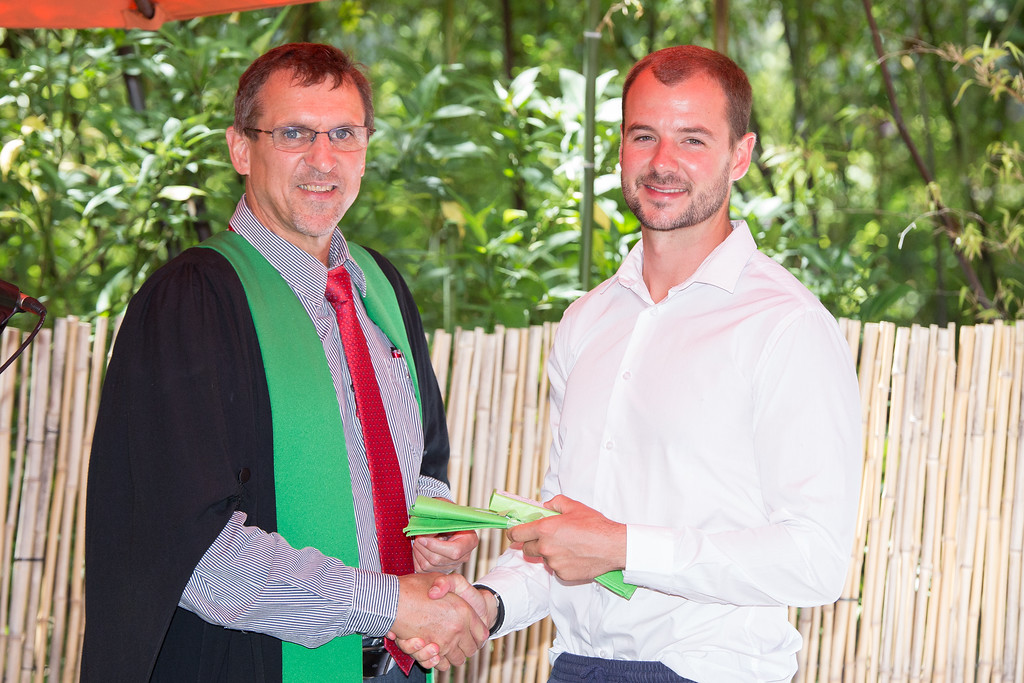From South Africa's indigenous Southern Cape forests to Tanzania, from the Miombo woodland in Zambia to North Ethiopia and West Africa – that's where their research has taken six new graduates of the Department of Forest and Wood Science at Stellenbosch University (SU). They are Dr Philip Crafford and Dr GP Scheepers of South Africa, Dr Francis Munalula of Zambia, Dr Amani Jackson of Tanzania, Dr Haile Wale of Ethiopia, and Dr Abiodun Alawode of Nigeria.
The six PhD graduates have all successfully pursued their individual dreams of completing their doctorates during the 2018 academic year – a new record for the Department. Collectively, they symbolize something more – the pursuit to expand and strengthen the knowledge base of researchers and managers working in the forest and wood sector in Africa.
“Over the past decade, the SU Department of Forest and Wood Science has committed itself to increasing both its teaching and research outputs. It is therefore very satisfying to see students graduating, and in record numbers at that," says Dr Brand Wessels, chair of the Department of Forest and Wood Science.
Stellenbosch University is the only university in South Africa offering a comprehensive four-year BSc degree programme in both Forest Science and Wood Product Science, thus covering the entire forestry value chain. It is also the only tertiary institution in South Africa providing an educational offering at BSc, MSc and PhD levels in both Forest and Natural Resource and Wood Products Science.
There are currently 135 undergraduate students and 35 postgraduate students in the Department of Forest and Wood Science, of whom 12 are working towards completing their PhDs.
“Our emphasis is on producing versatile managers and researchers for the wood processing and timber growing industries with the skills to manage and understand all the intricacies of technology transfer," says Dr Wessels. “This provides our graduates with fantastic career opportunities and allows them to diversify in other related industries."
Climate change studies
“We serve a sector that is of critical importance to one of the greatest challenges of our time – climate change," notes Dr Wessels. “As a Department we'd like to ensure that more research is done about the effects and mitigation of climate change in the forestry sector, and that we are able to train experts that can play a role in this regard."
To this end, the PhD in Wood Product Science completed by Dr Francis Munalula is of interest. He assessed whether changing climatic conditions and extreme events, such as droughts, have any influence on how three hardwood species commonly found in the Zambian Miombo woodlands grow.
The studied species were the Msasa or zebrawood tree (Brachystegia spiciformis), the wild syringa (Burkea Africana) and the Mupopa or Mutobo tree (Isoberlinia angolensis).
All were found to be resilient enough to withstand the effects of reduced rainfall and increased temperature. However, significant differences were found in the anatomical properties of wood from drier sites and in wood formed during very dry years.
“This will have a noticeable effect on the quality of wood, explains Dr Munalula.
As part of his study, he developed a model to predict how the anatomical properties of these tree species will change, given the variations in the climate that can be expected over the next fifty years.
Reducing Emissions from Deforestation and forest degradation, plus the sustainable management of forests and the conservation and enhancement of forest carbon stocks (REDD+), is an essential part of the global efforts to mitigate climate change, which is supported by the United Nations.
As part of his PhD in Forest Science, Dr Amani Jackson studied the perceptions of community members in the Kilosa District in Tanzania about whether participatory land use plans support the effective manage and conservation of local village land forest reserves.
His results once again underline how important it to use participatory processes when creating awareness and striving for community engagement when implementing such large-scale plans such as REDD+.
“This will ultimately enhance forest management and conservation," he notes. “To ensure community buy-in, it is important that the REDD+ initiative provides other benefits too, and not only carbon financing."
Closer look at forests
Dr GP Scheepers investigated factors that influence the reaction of semi-mature pines planted in the Tsitsikamma region of the Southern Cape to the use of fertilizer. He completed his studies in Forest Science by monitoring eight experimental stands of Pinus elliottii and Pinus elliotii x caribaea. Among others he took note of the influence of climatic conditions, the characteristics of the soil and the availability of water, nitrogen and phosphorus in the soil.
He found that soil with a too high/too low pH level lost its natural ability to mineralise nitrogen – an aspect needed so that plants can optimally take up fertilisers. The volume of water in the soil did not limit the growth of trees.
Dr Scheepers says indicators such as the levels of soil nitrogen, anaerobically incubated nitrogen and aerobically incubated phosphorus should be considered when planning silviculture activities.
“I hope findings help forest managers in the Tsitsikamma region to greatly improve the effectiveness of their fertilizer regimes," he notes.
For his PhD, Dr Haile Wale used analytical tools to gauge the ecological status of three Afromontane forests in north-western Ethiopia that have not yet been studied in detail. The forests are Alem Saga, Gelawudiwos and Tara Gedam.
He collected plant species from 150 plots and noted how the soil conditions, altitude and slope differed in each of these areas. He collected information on the species that occur together, and environmental factors, such as the availability of light and litter that play a role in how well they grow.
“The study provided basic ecological information on the species growing in the area and can guide better sustainable resource management and the conservation of these forests," Dr Wale believes.
Timber and adhesives
Formaldehyde-based adhesives made from non-renewable petrochemical sources are widely used in the production of wood composite products, because of their superior performance properties. However, it is known to hold serious health risks, and therefore it is important for the industry to consider alternative wood adhesives.
To this end, Dr Abiodun Alawode of Nigeria tested whether the seed kernels of two species of African or wild mango, Irvingia gabonensis and Irvingia wombolu could be used as an eco-friendly wood adhesive.
“The results indicate that Irvingia-based wood adhesives have comparable performance properties with formaldehyde-based wood adhesives and could be considered as an eco-friendly raw material from which to make wood adhesive," explains Dr Alawode, who obtained a PhD in Wood Product Science.
For further information about the Department, visit http://www.sun.ac.za/english/faculty/agri/forestry or contact Dr Brand Wessels at cbw@sun.ac.za
Main photo caption: At the April graduation ceremony of Stellenbosch University, Dr Philip Crafford, Dr Abiodun Alawode, Dr Francis Munalula and Dr Haile Wale received doctorates.

Dr Amani Jackson

Prof Danie Brink, dean of the Faculty of AgriSciences at Stellenbosch University, congratulated Dr GP Scheepers.

